

النبات

مواضيع عامة في علم النبات

الجذور - السيقان - الأوراق

النباتات الوعائية واللاوعائية

البذور (مغطاة البذور - عاريات البذور)

الطحالب

النباتات الطبية


الحيوان

مواضيع عامة في علم الحيوان

علم التشريح

التنوع الإحيائي

البايلوجيا الخلوية


الأحياء المجهرية

البكتيريا

الفطريات

الطفيليات

الفايروسات


علم الأمراض

الاورام

الامراض الوراثية

الامراض المناعية

الامراض المدارية

اضطرابات الدورة الدموية

مواضيع عامة في علم الامراض

الحشرات


التقانة الإحيائية

مواضيع عامة في التقانة الإحيائية


التقنية الحيوية المكروبية

التقنية الحيوية والميكروبات

الفعاليات الحيوية

وراثة الاحياء المجهرية

تصنيف الاحياء المجهرية

الاحياء المجهرية في الطبيعة

أيض الاجهاد

التقنية الحيوية والبيئة

التقنية الحيوية والطب

التقنية الحيوية والزراعة

التقنية الحيوية والصناعة

التقنية الحيوية والطاقة

البحار والطحالب الصغيرة

عزل البروتين

هندسة الجينات


التقنية الحياتية النانوية

مفاهيم التقنية الحيوية النانوية

التراكيب النانوية والمجاهر المستخدمة في رؤيتها

تصنيع وتخليق المواد النانوية

تطبيقات التقنية النانوية والحيوية النانوية

الرقائق والمتحسسات الحيوية

المصفوفات المجهرية وحاسوب الدنا

اللقاحات

البيئة والتلوث


علم الأجنة

اعضاء التكاثر وتشكل الاعراس

الاخصاب

التشطر

العصيبة وتشكل الجسيدات

تشكل اللواحق الجنينية

تكون المعيدة وظهور الطبقات الجنينية

مقدمة لعلم الاجنة


الأحياء الجزيئي

مواضيع عامة في الاحياء الجزيئي


علم وظائف الأعضاء


الغدد

مواضيع عامة في الغدد

الغدد الصم و هرموناتها

الجسم تحت السريري

الغدة النخامية

الغدة الكظرية

الغدة التناسلية

الغدة الدرقية والجار الدرقية

الغدة البنكرياسية

الغدة الصنوبرية

مواضيع عامة في علم وظائف الاعضاء

الخلية الحيوانية

الجهاز العصبي

أعضاء الحس

الجهاز العضلي

السوائل الجسمية

الجهاز الدوري والليمف

الجهاز التنفسي

الجهاز الهضمي

الجهاز البولي


المضادات الميكروبية

مواضيع عامة في المضادات الميكروبية

مضادات البكتيريا

مضادات الفطريات

مضادات الطفيليات

مضادات الفايروسات

علم الخلية

الوراثة

الأحياء العامة

المناعة

التحليلات المرضية

الكيمياء الحيوية

مواضيع متنوعة أخرى

الانزيمات
Plant Structure
المؤلف:
AN INTRODUCTION TO PLANT BIOLOGY-1998
المصدر:
JAMES D. MAUSETH
الجزء والصفحة:
24-10-2016
3009
Plant Structure
Plant structure is the physical, material body of a plant, composed of carbohydrates, proteins, lipids, minerals, water, and other components. In terms of both material and energy, it is expensive for an organism to build a body all the energy and resources used by a tree to construct its body could have been used instead for reproduction, increasing its number of offspring. The theory of evolution by natural selection predicts that organisms must receive enough benefit from their structure to offset the cost of building it: It must be more advantageous selectively to have a body than not to have one. The benefit is that the structure is the framework in which metabolism occurs and the means by which the metabolism interacts with the environment. This can be more easily understood by considering the alternative-organisms with very little structure.
Several organisms have almost no structure whatsoever: viroids, viruses, and myco-plasmas. All are parasites that live, grow, develop, and reproduce only if immersed within the body of a host organism. The host provides a benign environment with enough nutrients for the parasite while also being free of harmful chemicals. The temperature of the host's body is ideal for the parasite, and adequate water is available. Parasites cannot live outside the host-supplied environment. With minimal structure, they have minimal capacity to interact well with the heat, cold, drought, and scarcity of nutrients in a natural environment.
Organisms whose bodies are more structured and complex are able to resist temporary adverse environmental conditions as well as exploit optimal ones. A simple bacterium can absorb mineral nutrients from certain environments. But by constructing a root system, a plant can spread its mineral-absorbing metabolism throughout an extensive, deep volume, growing past dry, rocky, mineral-poor soil and tapping rich, fertile soil. The investment for the plant is great, but sufficient reward is achieved in having an adequate secure source of water and minerals.
As you study the material in this part, think about how the structures discussed facilitate the metabolism that occurs inside them: How do the structures make the metabolism more efficient? What are the selective advantages of the structures? Are alternative structures possible for a particular metabolism? If so, what are the consequences of each?
CONCEPTS
All organisms are composed of small structures called cells. In plants, each cell consists of a boxlike cell wall surrounding a mass of protoplasm, which in turn contains its own smaller parts, the organelles, such as nuclei, mitochondria, and chloroplasts (Figs. 1 to 3; Table1). Cells are also the physical framework within which a plant's metabolism occurs. Water and salts are absorbed from soil by root cells, they are transported throughout the plant by cells of the vascular tissues, and the energy of sunlight is used in leaf cells to convert carbon dioxide and water to carbohydrates. Plant reproduction is also based on cells and cell biology: Some cells in flowers produce pigments or nectar that attract insects which carry pollen between flowers, allowing sperm cells to contact egg cells.
Table 1: Example of Plant Cell Shapes and Sizes
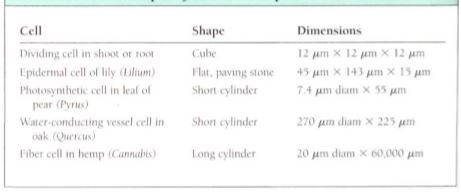
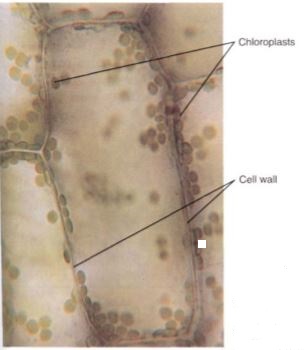
FIGURE 1 : A light micrograph of Elodea showing several basic features of a plant cell. The walls and chloroplasts are easily visible. Other organelles occur but are difficult or impossible to see by light microscopy (X 80).
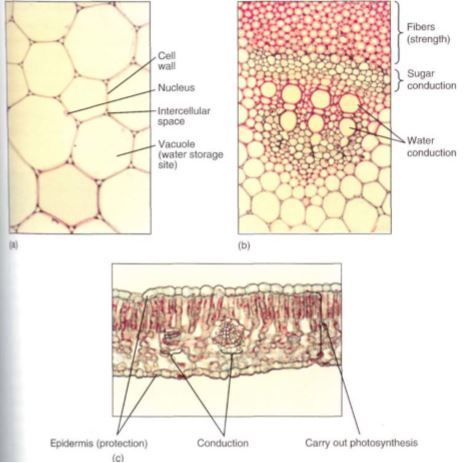
FIGURE 2: Plant metabolism, development, and survival depend on numerous cells working together in a coordinated, integrated fashion. (a) These cells store water in the center of a sunflower stem; they are relatively large and filled mostly with water. The cell walls and a nucleus are visible (X 250). (b) Part of the system that conducts water and nutrients in a sunflower stem. Numerous types of cells occur in specific arrangements that permit efficient conduction. The large red cells in the center conduct water; the small grey cells above them conduct sugars. The cells at the top have thick red walls and provide strength to the stem (X 60). (c) In this transverse section through a leaf of Ligustrum, you can see a variety of cells; those in the center carry out photosynthesis (X 150).
Considering the large number of living organisms and the numerous types of metabolism that must be carried out, one might suspect that there are hundreds of types of cells, but actually just a small number of cell types exists. Most differences between organisms are due to differences in associations of their cells, not in the cells themselves. Regardless of whether a root, stem, leaf, or flower is being constructed, the same basic units—cells—are required (Fig. 4). Only the cell associations and minor modifications of the cells themselves change from tissue to tissue or organ to organ .
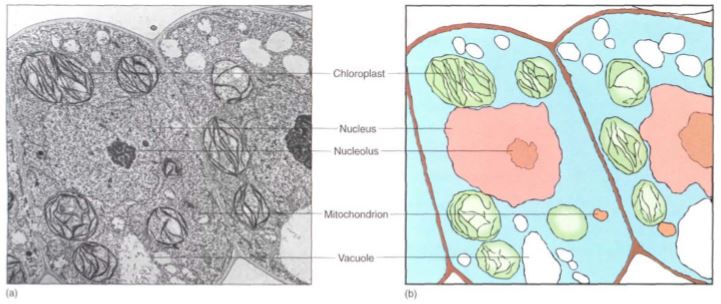
FIGURE :3 A micrograph made with a transmission electron microscope of leaf cells. Especially important are the numerous membranes (X 17,000).
Although only a few types of cells exist, their differences are important. Any organism composed of more than one cell (a multicellular organism rather than a unicellular one) always has several types, each specialized for different tasks (see Figs. 2 and 4; Table 2). As a plant develops, the cells in various parts become especially adapted for specific tasks. This division of labor allows the whole organism to become more efficient. Unicellular organization has a significant consequence: It does not allow division of labor or specialization. Each cell must perform all tasks sensing the environment, gathering nutrients, excreting wastes, defense, movement, and reproduction. Because each cell must perform all tasks, it cannot do any one very well. Mutations that make a cell well adapted £r protection make it less adapted for other functions and therefore are selectively disadvantageous (Fig. 3.5). The same is true for modifications that improve photosynthesis, reproduction, and so on. Multicellularity and division of labor result in a more efficient organism, but they have negative consequences as well: As each cell becomes more specialized, it depends more on the others. If a cell evolves toward having thick walls and offering maximum protection, it must rely on other cells of the organism for photosynthesis, mineral absorption, and reproduction. Damage to one part of the organism may result in the death of all cells, even those not initially damaged, whereas in a unicellular organism, a cell dies only if it is damaged directly. Which is more advantageous selectively—a unicellular organism com-posed of one generalized cell or a multicellular organism composed of specialized ones? The answer is not so obvious: Both types have existed for hundreds of millions of years, so both must be considered highly adaptive and successful.
TABLE 2: Examples of Plant Cell Types, Specializations, and Division of Labor

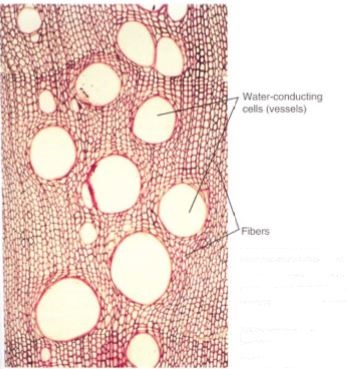
FIGURE 4 : Transverse section of wood showing several cell types: Fibers with thick walls provide strength, and large open cells conduct water. These cells act as building blocks, and more wood is easily constructed by adding more cells. Stronger wood is produced by adding more fiber cells; more conductive wood results from adding more open cells (X 100).
Like whole individuals, cells have a life span. During their life cycle (cell cycle), cell size, shape, and metabolic activities can change dramatically. A cell is "born" as a twin when its mother cell divides, producing two daughter cells. Each daughter cell is smaller than the mother cell, and except for unusual cases each grows until it becomes as large as the mother cell was. During this time the cell absorbs water, sugars, amino acids, and other nutrients and assembles them into new, living protoplasm. Once the cell has grown to the proper size, its metabolism shifts as it either prepares to divide or matures and differentiates into a specialized cell. Both growth and development require a complex and dynamic set of interactions involving all cell parts. That cell metabolism and structure should be complex would not be surprising, but actually they are rather simple and logical. Even the most complex cell has only a small number of parts, each responsible for a discrete, well-defined aspect of cell life.

FIGURE 5: (a) Cells located at the growing tip of Pinus (pine) are specialized for cell growth and division: Their thin cell walls allow sugar, water, and other nutrients to enter the cells easily. But these cells are too soft and weak to be useful as bark or the shell of a nut (X 400). (b) These "stone cells" provide strength in a coconut shell (Cocos nucijera) and therefore protect the seed. Almost the entire cell volume is wall. Protoplasm was present when the cells were young, growing and synthesizing their walls, but once the walls were completed, cell metabolism was not necessary and the protoplasts died (remnants are present in the tiny black hole in the center of each cell). Such modifications make it impossible for a stone cell to be a dividing, growing cell as in (a) (X 200).
 الاكثر قراءة في مواضيع عامة في علم النبات
الاكثر قراءة في مواضيع عامة في علم النبات
 اخر الاخبار
اخر الاخبار
اخبار العتبة العباسية المقدسة

الآخبار الصحية















 قسم الشؤون الفكرية يصدر كتاباً يوثق تاريخ السدانة في العتبة العباسية المقدسة
قسم الشؤون الفكرية يصدر كتاباً يوثق تاريخ السدانة في العتبة العباسية المقدسة "المهمة".. إصدار قصصي يوثّق القصص الفائزة في مسابقة فتوى الدفاع المقدسة للقصة القصيرة
"المهمة".. إصدار قصصي يوثّق القصص الفائزة في مسابقة فتوى الدفاع المقدسة للقصة القصيرة (نوافذ).. إصدار أدبي يوثق القصص الفائزة في مسابقة الإمام العسكري (عليه السلام)
(نوافذ).. إصدار أدبي يوثق القصص الفائزة في مسابقة الإمام العسكري (عليه السلام)


















